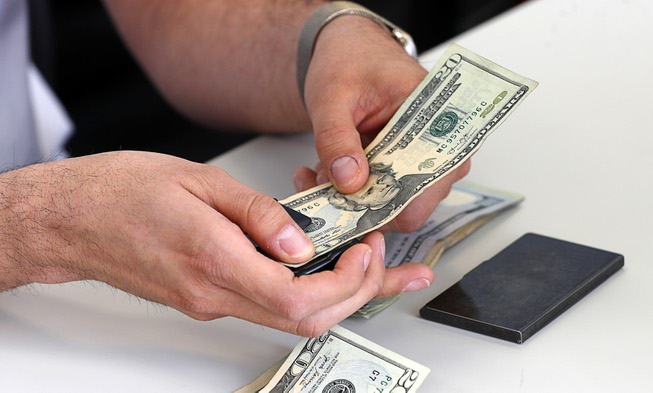
Ivan Delgado, a small business owner, uses a iBill reader to identify banknotes at a Nevada Department of Employment, Training and Rehabilitation (DETR) office on West Charleston Boulevard Friday, March 22, 2024. The device reads aloud the denomination of a bill so that blind people can identify them.
Thursday, March 28, 2024 | 2 a.m.
For the past eight years, Ivan Delgado has operated snack stands in public buildings in Clark County, where his days are spent selling concessions to workers and visitors alike.
The task of taking a cash payment can be challenging because Delgado is visually impaired. Currency is multicolored in many countries, but in the United States our money is the same monochromatic green, regardless of the denomination, which creates an obstacle for those who are vision impaired.
That’s where the Nevada Department of Employment, Training and Rehabilitation (DETR) is assisting. It is aspiring to empower Nevada’s blind population to participate in the economy with more independence by distributing the iBill Currency Reader to blind or visually impaired residents at no charge.
The device retails for $179.99 but the U.S. Bureau of Engraving and Printing provides it for free to eligible individuals. DETR’s Bureau of Services to the Blind and Visually Impaired is the first agency in the state to distribute iBill readers through a recently formed partnership with the Bureau of Engraving and Printing, and is making the devices available to eligible individuals plus schools, with a potential for other places such as doctor’s offices and nonprofits that work with the blind. It has assisted in distributing 60 readers since becoming involved with the program a few months ago.
“You want to give your child money for movies, right? Teenagers, they can be very devious, so you don’t want to give them a $20 bill thinking it’s a $50 or $5,” says Ani Severtsen, a rehabilitation instructor with Bureau of Services to the Blind and Visually Impaired.
Users of the device simply need to insert a bill into the reader, which is smaller than a credit card, and press a button. A voice will announce the bill’s denomination.
Users can also program the device to beep according to the denomination. And for those who are blind and deaf, the device can be set up to vibrate instead of beep.
“Just because you’re blind, doesn’t mean you can’t find ways of making money,” Delgado said.
Before the device, some blind people organized their money by folding it a certain way in their wallet according to its denomination. Others would simply organize their wallet with the bills in order of denomination.
But both methods rely on having a sighted person’s assistance. That’s no longer the case.
By giving blind people more independence, the reader is positively impacting the economy, said Richele Pennock, a rehab supervisor for DETR.
“It would be tremendous because people can then identify their currency and be full participants and consumers in the economy and have confidence in their transactions and not have to be reliant and dependent on other people,” Pennock said. “And so they could be a lot more free and self-sufficient with their involvement in the economy.”
Samuel Hall became blind in 2020 because of diabetic retinopathy and says he misses seeing his wife’s face. A pianist at a local church, Hall remembers going to McDonald’s after a service and using his bill device to count his change — a transaction that impressed both the cashier and his friends, he said.
“I really like this thing because it’s vocal,” Hall said. “I can hear it talking to me. I wish a lot more stuff did this.”
The bureau has also helped him adjust to cooking. It gave him a set of adhesive tabs to put on the buttons of his air fryer with each having a unique texture for different lengths of time. With Severtsen’s help, he’s also learning to remaster tasks like peeling a carrot.
“I just (have to) learn a different way of doing stuff,” says Hall, who also utilizes a talking watch and scale.
It’s part of an ongoing effort by officials with DETR to help the state’s blind community adapt.
Some clients benefiting from the new technology are participants in the Business Enterprises of Nevada program, which, under state law, provides a priority right for individuals who are legally blind, like Delgado, to operate food-and-beverage routes inside public buildings.
Delgado started in the program in 2016 at Clark County Family Court and now operates in a Department of Motor Vehicles office.
He remembers some customers at the Family Court pulling stunts such as stealing an entire box of candy bars.
But he says he took the store from making $50 a day to $800 a day. And with the new device, his days are certainly less hectic.
Delgado describes the device as “very fast” and “very accurate,” using bills from his wallet to demonstrate how it works.
More help could be on the horizon, Severtsen said.
Severtsen says after extensive advocacy by American Council for the Blind and National Federation of the Blind, the federal government agreed to hear suggestions from the community about accessibility features on currency.
The U.S. Bureau of Engraving and Printing brought prototypes to some conventions where Severtsen and other participants gave feedback on the bills’ raised lines and colors.
In 2011, the bureau committed to their suggestions of tactile, raised lines on the bills and higher contrast in the numbers and colors, she said. In 2026, they will begin printing its new blind-friendly $10 bill.
“You can never have too many accessibility features,” Severtsen says.
To obtain a free currency device reader, apply online at bep.gov/services/currency-accessibility/us-currency-reader-program.
[email protected] / 702-990-8923

